Analyzing Intel Core M Performance: How 5Y10 can beat 5Y71 & the OEMs' Dilemma
by Brett Howse & Ian Cutress on April 8, 2015 8:00 AM ESTPCMark 8 Creative Results
The Creative suite for PCMark changes the workloads out a bit, and is overall a much longer benchmark. Creative includes web browsing, photo editing, video editing, group video chat, media transcoding, and gaming workloads, so like the previous test the higher resolution of the Yoga 3 Pro will bring its scores down compared to the 1080p of all of the other devices. Like PCMark 8 Home, the work features high demand followed by low demand.
The Core i5 performs much the same as during the Home benchmark. Clearly the cooling system which is designed to get rid of 15 watts of heat can pretty easily cope with these types of workloads, and it even allows the CPU to turbo quite often to the CPU’s maximum speed of 2.7 GHz. GPU workloads are also no issue for the cooling system. None of the 4.5 watt TDP devices fare so well though, and as with the Home benchmark we see the Yoga 3 Pro having quite good CPU and GPU frequencies. The Dell is limited quite a bit more on temperature, and the ASUS is limited by its lack of maximum turbo frequency.
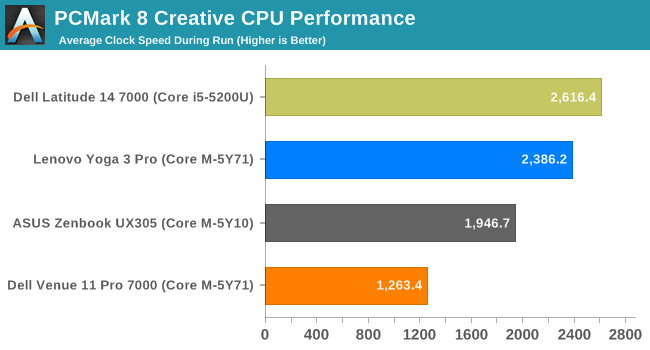
Looking at the average CPU frequency tells a big story of thermal limitations on the Dell Venue 11 Pro. With an average that is barely over its base of 1.2 GHz, the device spends a significant amount of time below its base frequency. The UX305 keeps its consistency high, with it almost reaching its maximum turbo clock, while the Yoga 3 Pro ends up quite a bit faster.
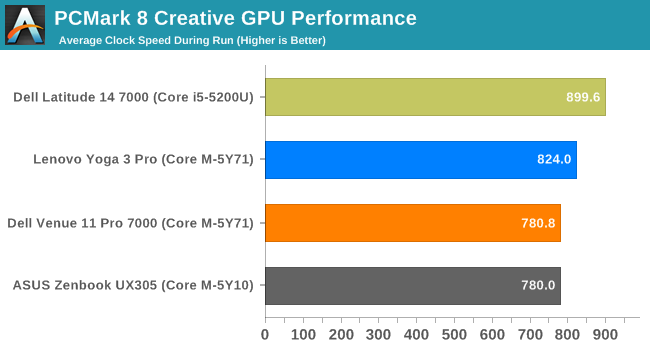
The GPU story has the ASUS bumping into its maximum GPU speed of 800 MHz, keeping pace with the Dell Venue 11 Pro which can go as high as 900 MHz. The Yoga 3 Pro is over 800 Mhz, here, showcasing its active cooling solution and meaning it is certainly spending time closer to its 900 MHz GPU turbo.
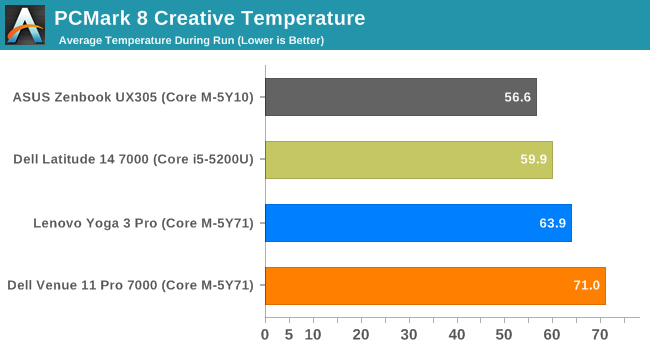
Looking at average temperatures, it is obvious why the ASUS can stay close to its maximum turbo on many workloads. After this one hour benchmark, the CPU average was just over 56°C despite the passive cooling. The active cooled Broadwell-U laptop is a bit higher, and the Yoga 3 Pro kept its average under its 65°C CPU maximum.
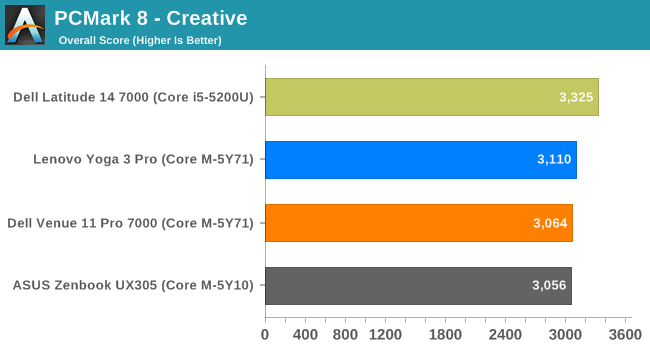
The Lenovo Yoga 3 Pro scores the highest of all three Core M devices in this benchmark despite the higher resolution display. On this type of workload where the actual work is much shorter, it keeps its CPU frequency much higher than all of the other Core M devices. The Venue 11 Pro also outscores the UX305 despite its low average CPU frequency. When needed, it was able to turbo well past the 2 GHz maximum of the 5Y10 device.


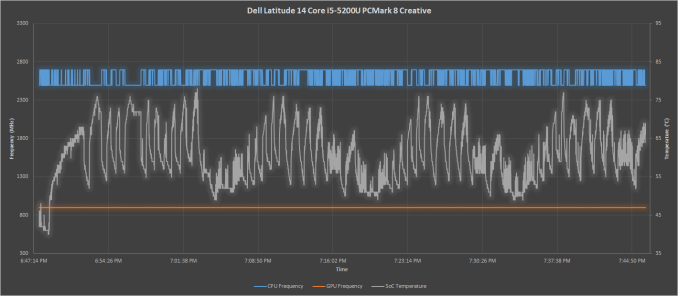
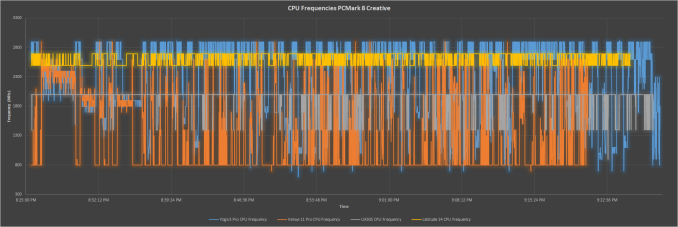
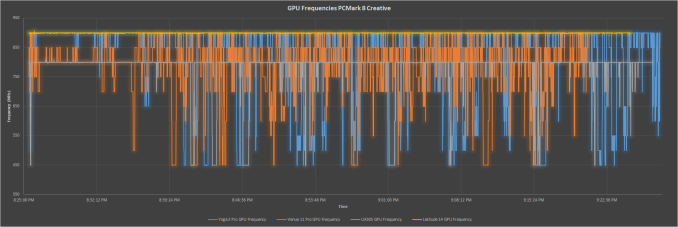
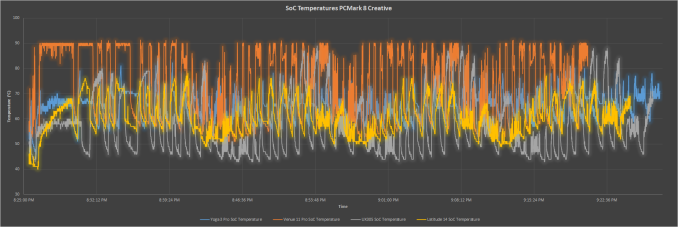








110 Comments
View All Comments
seapeople - Thursday, April 9, 2015 - link
Won't an over-aggressive turbo actually decrease performance? Processors are generally less power efficient at higher clock speeds, i.e., running at 3GHz is twice as fast as 1.5GHz but generally uses more than 2x the power, and thus more than 2x the heat.In this case, therefore, a processor that races to 3GHz will quickly (and less efficiently) use up its thermal headroom and have to throttle back moreso than a processor that stayed at 2GHz.
It's like a footrace - if the race is 100m long, you're going to finish fastest if you go all out. However, if the race is a mile long, then the guy who starts off sprinting is going to be sputtering along a quarter of the way into the race as the joggers pass him up.
MrSpadge - Friday, April 10, 2015 - link
You are right that with agressive Turbo the chip is running in a less power efficient state initially and will have to throttle a bit earlier than a slower, steadily running chip. but if we're talking about low performance under sustained loads, this doesn't matter: it affects the first few seconds, or 10's of seconds at most, whereas in the following minutes both systems are running at the same power efficient throttled speed, which is basically determined by the system cooling. It's not like the sprinter who's completely exhausted and can't recover.retrospooty - Wednesday, April 8, 2015 - link
I dont think its really all that complicated... If you are looking for raw performance, Core M isnt for you. It is really for low power devices that do basic stuff like browsing, email etc. For that purpose, its one hell of a CPU. That performance level at 4.5 watts is a hefty accomplishment IMOYuLeven - Wednesday, April 8, 2015 - link
I do development on a Core M machine. Instead of carrying 4 pounds of computing power on my back, I let a cloud based development box do the heavy lifting. The plume light Core M notebook is used basically to write the code and give orders to the Dev box. IMHO opinion a far better setup than having scoliosis for the sake of running code locally.mkozakewich - Wednesday, April 8, 2015 - link
It's not for web browsing. That's what Atom is for. A Core-M device is good for all regular core tasks except sustained graphics tasks. I wouldn't get one to game, but it'll be great for anything else.retrospooty - Thursday, April 9, 2015 - link
That is pretty much exactly what am saying. Basic use, core M is fine. Not for high performance requirements.nathanddrews - Wednesday, April 8, 2015 - link
They have taken the exact opposite approach to their SSD design, where they try very hard to offer constant and consistent performance.xthetenth - Wednesday, April 8, 2015 - link
Both make sense from the perspective of increasing perceived speed. With storage, it hanging and being slow is the biggest way it can impact the feel of the device, while processors that trade finishing short tasks much faster for a tiny decrease in how fast they complete long tasks do a lot to achieve a responsive feel.xthetenth - Wednesday, April 8, 2015 - link
Device buyers don't buy devices to get a higher average frequency, they buy things to do what they want without the device holding them up. Look at the benchmarks where the ASUS holds higher average frequencies but the Yoga's higher maximum frequency means it completes tasks faster, and it performs better in the benchmark. That sort of responsiveness is what turbo is for. The time to complete long tasks isn't going to be materially changed but the time to complete short tasks is going to be reduced significantly if the processor can use a quick burst like turbo allows.I'm also pretty sure that most users consider not getting burned by their device a good thing that should continue, incidentally.
StormyParis - Wednesday, April 8, 2015 - link
That's not a real use case though. Real use case is load a page (low CPU), render page (high CPU) read page (low CPU). I don't care how fast my CPU is idling while I'm reading the page, I do care how fast the page renders. It'd be different if I were running simulations.. that's what desktop CPUs are for.